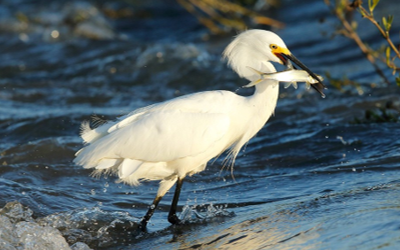Upwells and Shells: Protecting Estuaries from Acidification

Published July 18, 2023
When we think of biodiversity, we tend to summon images of rainforests and jungles, insects crawling on sweating leaves and being scooped up by vibrant birds. Most don't envision estuaries to be teeming with just as much life, despite being ideal nooks for myriad species to thrive. These pockets of biodiversity are often called the nurseries of the sea for this reason. Estuaries exist where freshwater and saltwater mingle, the flow from the tides and currents of the ocean in constant traffic as they bring nutrients inland. These same traits, however, also make estuaries vulnerable to acidification.
The pH of regular drinking water is usually around seven, which is neutral on the pH scale. Adding carbon dioxide to a liquid causes its pH to become acidic. The ocean absorbs around a quarter of the carbon dioxide in our atmosphere. The more carbon dioxide there is available for absorption, the more the ocean takes in and the more acidic it becomes. Acidification has multiple repercussions, especially on marine life like shellfish and coral reefs that rely on calcification to survive. Being surrounded by acidic water hinders these organisms’ abilities to build and maintain their shells and skeletons, and this can have a domino effect on the rest of the ecosystem. Damaged shellfish and coral reefs make it harder for the food webs that rely on them to survive, which in turn affects fisheries and the communities that rely on them.
Proximity to human activity is another factor that makes estuaries vulnerable to acidification. Estuaries exist in diverse regions throughout the country, so there can be many different environmental factors that drive changes in acidity, depending on the estuary. In some estuaries, discharges from agriculture and wastewater may be the cause of the increase in acidity, and in others, an increase could be mostly caused by elevated atmospheric carbon dioxide from other human activities. Due to multiple contributing factors that influence acidification, it's important to monitor estuaries meticulously to understand which factors affect them and when. Through EPA's National Estuary Program (NEP), researchers can closely monitor estuaries across the country based on priorities identified by community members including local and non-profit organizations. In 2015, EPA and NEP partners began monitoring ten estuaries throughout the U.S. using sensors that measure dissolved carbon dioxide and pH. These two measurements can be used to characterize the carbonate chemistry of the water in the estuaries and indicate when and where calcifying organisms may be impacted by acidification. By measuring dissolved CO2 and pH repeatedly over the course of a few years, researchers have been able to observe detailed changes in carbonate chemistry that would be difficult to detect through periodic sampling alone. This type of monitoring is crucial because it analyzes measurements at time and space scales relevant to the abundance of marine life in these rich environments.
Through these methods, EPA researchers and NEP partners found that regional factors heavily influence acidification in estuaries. Upwelling events, which happen when strong winds move surface water and cause water underneath the surface to rise to replace it, have an especially strong influence on acidification. Land-based freshwater inflows, which are often more acidic than ocean water, are another factor, in addition to nutrient and organic matter inflows from watersheds. Thanks to the careful monitoring by EPA and NEP, these types of community-specific factors can be captured and addressed.
Kristi Foster, the executive director of Tillamook Estuaries Partnership (TEP), an NEP partner that worked closely with EPA researchers during this project, noted “scientists have collaborated with TEP and local partners to address global issues like [ocean acidification and hypoxia] at a local level, making our communities and economies less vulnerable to future challenges and changes. Together, we are working to protect species that rely on the estuaries for their survival, including oysters, Dungeness crabs and threatened coho salmon.”
Since acidification is especially affected by human activity and nutrient dynamics in coastal environments compared to the open ocean, more research is needed to understand where nutrients come from and how they move within estuaries so that communities can take action to protect them. As more information is collected by EPA and partners over time, we can be better equipped to preserve these rich nurseries.
